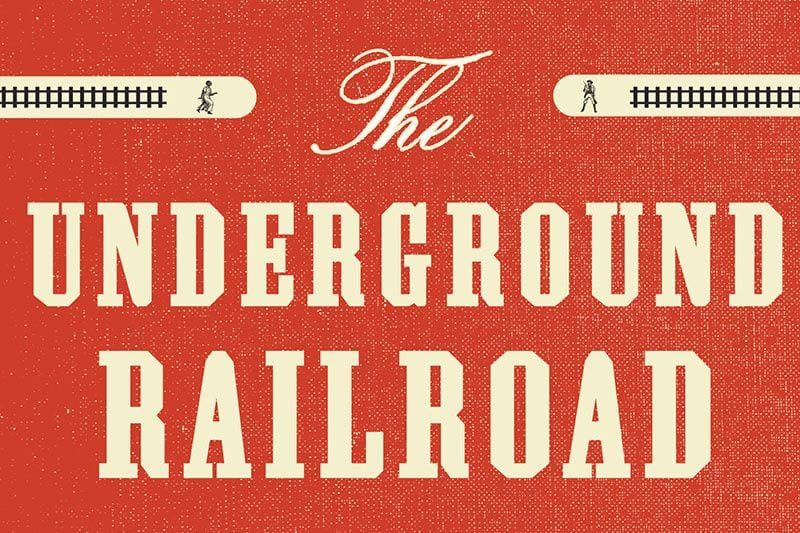
Colson Whitehead’s The Underground Railroad will become a canonical text, if it isn’t already. The novel shares affinities with the works of Toni Morrison, Zora Neale Hurston, James Baldwin, and Frederick Douglass, while contributing to contemporary discourses on race. Winner of the 2017 Pulitzer Prize for Fiction and the 2016 National Book Award for Fiction, Whitehead’s storytelling is vivid while his critique of America’s fundamental principles is dynamic.
The Underground Railroad is told through the life of the runaway slave, Cora. The novel begins on a Georgian plantation owned by the sadistic Mr. Randall. He enacts brutal violence in order to satisfy his own thirst for profit while creating a culture of subservience. Cora escapes the plantation assisted by another slave named Caesar. As she moves North, each state presents a different manifestation of terror. Throughout the novel Cora faces fear, humiliation, and the toxicity of systematic racism. Arguably these are the common characteristics of many slave narratives. However Whitehead’s novel stands alone for the raw parallels to contemporary society. The author does not lean on moralism to convey the text’s power, yet it’s impossible for any reader to avoid the correlations.
At times the novel attempts to be multigenerational. Readers learn about the capture of Cora’s grandmother Ajarry, stolen from her West African village and shipped across the Atlantic in a disease infested slave ship. Ajarry’s narrative connects to that of her daughter Mabel ,who was the only slave to flee Randall Plantation and evade capture. That leads to her daughter Cora, from whom the novel springs forth. These women demonstrate a commonality that’s more than familial; the impact of mercilessness and trauma live on in their bloodlines through generations. America has yet to address this.
The backstories for the secondary characters are light and in some cases underdeveloped. Characters such as Caesar or Mingo, or even Cora’s mother and grandmother, despite central to the protagonist’s motives, are infrequently more than a plot device. The novel’s center, however, is Cora, who bears witness to systematic violence and oppression. Perhaps it’s unfair to critique Whitehead too harshly for failing to include each character’s testimony. There’s simply not enough time to fully develop each narrative.
The Underground Railroad is a work of fiction and this is evident by the historical liberties Whitehead utilizes. His underground railroad is a literal locomotive equipped with tracks, station agents, and tunnels instead of the series of safe-houses composing the actual clandestine network. Whitehead’s railroad is allegorical and reflects the erasure of African traditions and the problems plaguing African American culture to this day. Subsequently, the potential magnificence of the black experience becomes subterranean. As a result, readers are forced to question why only violence and oppression are anomalous to the black experience in our dominating narratives, when in fact African Americans have, in spite of this violent history, contributed greatly to the cultural and intellectual discourse of this nation.
Whitehead’s writing is magnificent while his storytelling strikes an emotional timbre that moves and infuriates, discourages but then reconstructs hope. for example:
Sometimes a slave will be lost in a brief eddy of liberation. In the sway of a sudden reverie among the furrows or while untangling the mysteries of an early morning dream. In the middle of a song on a warm Sunday night. Then it comes, always – the overseer’s cry, the call to work, the shadow of the master, the reminder that she is only a human being for a tiny moment across the eternity of her servitude (28).
Truly barbarous, the descriptions demonstrate the extent of the violence against these subjugated people. In North Carolina Cora learns that the entire state expunged the black population and “the negro race did not exist except at the ends of ropes” (159). The language Whitehead utilizes is grisly by its vividness but necessary because of the historical reality. There’s reason to believe that hyperbole might taint some of the novel. Yet dismissing the slave narrative genre as too gruesome is myopic. Whitehead reminds readers that the United States is a nation built by violence. Social and racial harmony or even the notion of a post-racial society are delusions if we continue to ignore that America’s “foundations are murder, theft, and cruelty” (285).
Cora’s time in North Carolina also reminds readers to be critical of the historical record. The abolitionists who harbor Cora question their motives because they are terrified. The public lynchings that occur across the street from their home serve as a nightmarish panopticon underscoring their trepidation. Reluctant abolitionists are infrequently discussed in mainstream historical narratives. Typically abolitionists are framed as confident victors who rarely questioned their resistance: the archetypal white hero. The Underground Railroad disrupts our understanding of a comforting history while warning against anesthetizing the past.
Originally published in 2016, the need for texts such as The Underground Railroad is as necessary as ever. The character Arnold Ridgeway, the malevolent and tireless slave catcher, is an allegory for ICE agents and the contemporary culture of fear. Ridgeway wasn’t able to capture Mabel and his vendetta against Cora stems from unadulterated bloodlust. He believes in racial inferiority and the need to subjugate. Even parts of his speech and mission to protect “the American spirit… and destroy that what needs to be destroyed” (226) reflects modern xenophobic and isolationist diatribes.
It’s easy to let texts such as The Underground Railroad render the belief that nothing has changed except the players. But that’s not true. The Underground Railroad reiterates that social awareness and understanding of history can overcome contemporary fear mongering and voodoo racial harmony. Thereby Cora’s consistent need to move, speak-up, and adapt reminds readers to do the same.

